#Clan MacDonald
Text
A hoard of coins linked to a Highland chief – which may have been stashed away as he tried in vain to escape the Glen Coe massacre – has been discovered underneath a fireplace.
The 17th-century collection of 36 coins included international currency, and was hidden beneath the remains of a grand stone fireplace at a site believed to have been a hunting lodge or feasting hall.
The site was associated with Alasdair Ruadh “Maclain” MacDonald of Glen Coe, the clan chief from 1646-92, who, along with his family, was a victim of the massacre that followed the first Jacobite rising.
The MacDonalds took part in the 1689 effort to restore the Catholic James II of England and Ireland and VII of Scotland, after his deposition by his Anglican daughter Mary and her husband, William of Orange.
As government forces quelled the rebellion and sought to enforce peace terms, the clan was targeted – ostensibly for being among those to have failed to take an oath of allegiance to the Protestant monarchs in time. An estimated 82 clan members were killed on 13 February 1692; including Maclain and his wife.
Artefacts discovered at “the summerhouse of Maclain”, included European pottery, and silver and bronze coins, dating from the 1500s to 1680s, during a University of Glasgow dig in August.
13 notes
·
View notes
Text

The beauty of Glencoe in winter belies the tragic events of 1692
#Vale of Glencoe#Scottish Highlands#Clan Campbell#scenery#natural beauty#Clan MacDonald#massacre#winter landscape#British history#Ballachulish#Argyll#13 February 1692#UK
30 notes
·
View notes
Photo





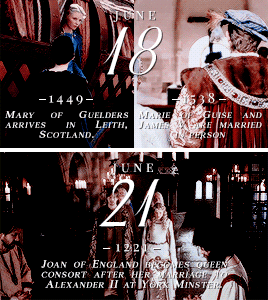




Scotland’s Ladies Month in History ✧ JUNE
#historyedit#on this day in history#scottish history#british history#history#queen consorts#queens regnant#princesses#clanswomen#house of stewart#house of dunkeld#house of stuart#clan cameron#clan macdonald#gifs#monthinhistory#ours#gifshistorical#kingdom of scotland
249 notes
·
View notes
Text
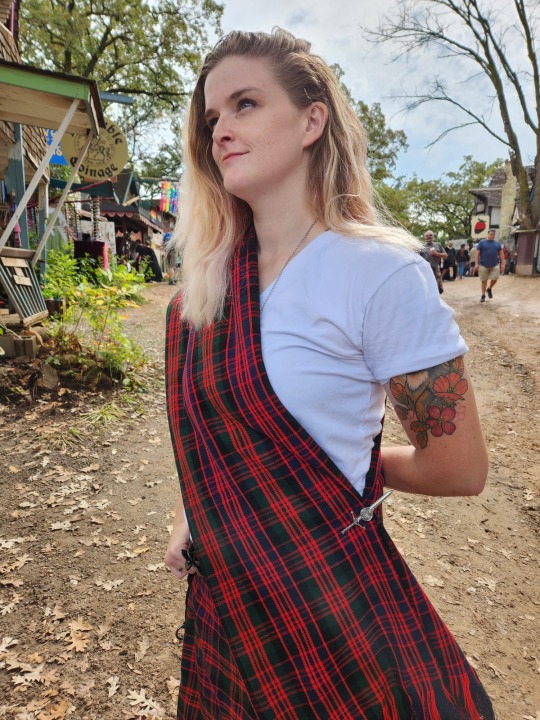
Love being able to wear my colors at least once a year
6 notes
·
View notes
Text

Er, so, Ichiji's voice actor sings this song, and at about the 1:43 mark, there's a musical interlude that sounds kind of like bagpipes to me.
So, bagpipes!
#one piece#vinsmoke#vinsmoke ichiji#ichiji#my art#vinsmoke brothers#vinsmoke family#not that it matters but the tartan is from clan MacDonald Lord of the Isles
44 notes
·
View notes
Text

Scottish Coin Hoard Could be Linked to 1692's Glencoe Massacre
Coins found under a fireplace may have been hidden there by a victim of the infamous Massacre of Glencoe, according to archaeologists.
Almost 40 members of Clan MacDonald of Glencoe were killed in February 1692 after soldiers were ordered to attack them.
A student discovered the money at the site of a house linked to the clan's chief.
Lucy Ankers was on her first dig when she made the find.
The 36 coins were inside a pot which had a small round pebble as a lid and had been placed beneath a hearth stone slab in the fireplace.
The discovery was made in August during an excavation at the site of the ruined house, led by archaeologists from the University of Glasgow.
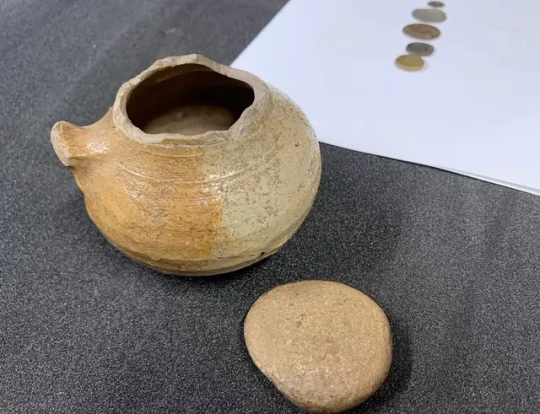
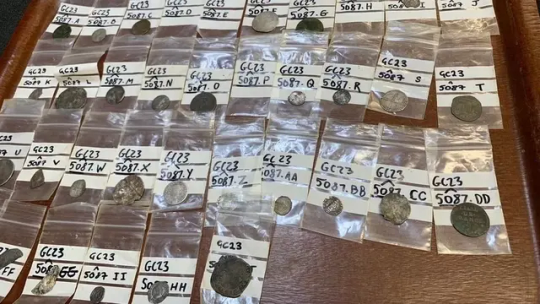
The property was associated with clan chief Alasdair Ruadh "MacIain" MacDonald of Glencoe.
He was among the estimated 38 people killed in the massacre.
Ms Ankers said: "As a first experience of a dig, Glencoe was amazing.
"The two weeks I spent digging solidified that I want to pursue a career within archaeology."
She added: "I wasn't expecting such an exciting find as one of my firsts, and I don't think I will ever beat the feeling of seeing the coins peeking out of the dirt in the pot."
The MacDonalds were targeted because of their support for the exiled King James VII of Scotland and II of England.
The clan backed the restoration of the Stuart dynasty to the British throne and had taken part in the first Jacobite Rising of 1689.
Historians say they were late delivering an oath of allegiance to the Protestant King William III, and had been branded as rebels by the Secretary of Scotland, Sir John Dalrymple.
In late January 1692, about 120 soldiers from the Earl of Argyll's Regiment of Foot arrived in Glencoe from Invergarry led by Capt Robert Campbell of Glen Lyon.
The troops were billeted with members of the clan, before turning on their hosts on 13 February.
Some people tried to escape in a snow blizzard to nearby glens, including Gleann Leac-na-muidhe, where the coin hoard was found.
The University of Glasgow has suggested a number of reasons why the money could be connected to the massacre.
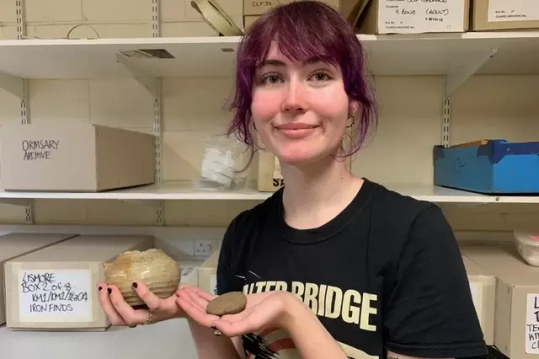
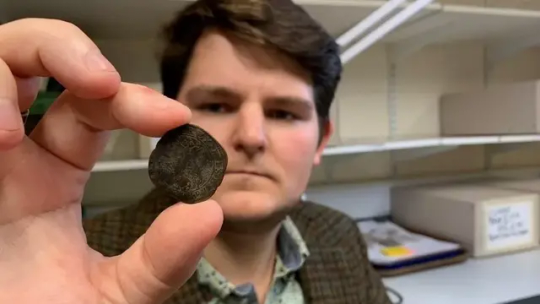
None of the coins were minted after the 1680s, which has led archaeologists to suggest they were most likely deposited under the fireplace either just before or during the killings for safekeeping.
The archaeologists also said whoever buried the coins did not return for them, possibly indicating they were among the victims of the massacre.
The coins are dated from the late 1500s through to the 1680s, and include pieces from the reigns of Elizabeth I, James VI and I, Charles I, the Cromwellian Commonwealth, and Charles II.
There were also coins from France and the Spanish Netherlands, as well as one coin which appears to have originated in the Papal States.
Dr Michael Given, a co-director of the archaeological project in Glencoe, said: "These exciting finds give us a rare glimpse of a single, dramatic event.

"Here's what seems an ordinary rural house, but it has a grand fireplace, impressive floor slabs, and exotic pottery imported from the Netherlands and Germany.
"And they've gathered up an amazing collection of coins in a little pot and buried them under the fireplace.
"It's a real privilege, as archaeologists, to hold in our hands these objects that were so much part of people's lives in the past."
University of Glasgow excavations director Edward Stewart added: "The excavation of MacIain's Summerhouse allows us to better understand the importance of these uplands to local elites.
"The scale of this structure and the wealth of artefacts uncovered within suggest this was a place where the MacDonald chiefs could entertain with feasting, gambling, hunting and libations.
"The discovery of this coin hoard within the structure adds an exciting dimension to this story.
"However, ordinary and everyday finds within this structure such as spindle whorls for making thread, a pitch fork and a dress pin, speak to the everyday lives of those who lived here, worked the land and minded the cattle."


#Scottish Coin Hoard Could be Linked to 1692's Glencoe Massacre#Clan MacDonald of Glencoe#clan chief Alasdair Ruadh “MacIain” MacDonald of Glencoe#King James VII of Scotland#King William III#coins#collectable coins#ancient coins#ancient artifacts#archeology#archeolgst#history#history news#ancient history#ancient culture#ancient civilizations#scottish history
51 notes
·
View notes
Text


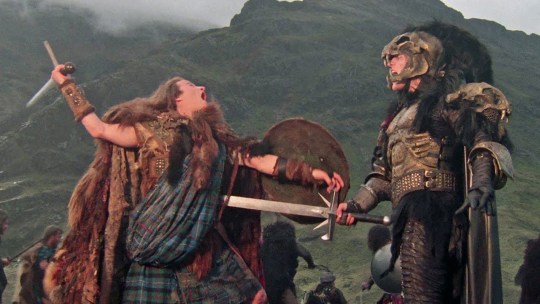
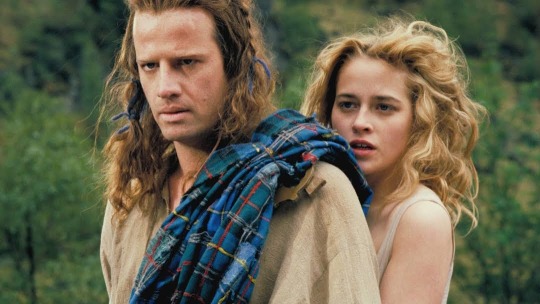


Highlander (1986)
La película cuenta la historia de los inmortales, humanos que solo pueden morir mediante la decapitación y que han existido a lo largo de los tiempos. Uno de ellos, el protagonista de la película, es Connor MacLeod, del clan escocés MacLeod, mientras que su enemigo es conocido como El Kurgan; junto a ambos personajes, la película muestra o menciona a otros cuatro inmortales, aunque parece claro que el número de los mismos sería mucho mayor.
El destino de los inmortales es combatir entre ellos en duelos para alcanzar el Premio, que obtendrá el vencedor del duelo final.
La naturaleza exacta del Premio no queda clara, aunque parece consistir en un poder y sabiduría que permitiría al ganador guiar al mundo a una nueva era ya sea de paz u oscuridad, dependiendo de la naturaleza del vencedor.
El clan MacLeod:
De acuerdo con la película, Connor MacLeod nació en el año 1518 en las Highlands (Tierras Altas) escocesas, en la aldea de Glenfinnan a orillas del Lago Shiel. En 1536, a la edad de 18 años, Connor partió con su clan a combatir frente al clan Frazer rival, en lo que sería su primera batalla. Entre las filas del clan Frazer se encontraba el Kurgan (Clancy Brown), un gigantesco inmortal de las estepas rusas nacido en el I milenio a. C., que al parecer tenía conocimiento previo de la condición de Connor como pre inmortal, algo que el propio Connor desconocía.
El Kurgan consiguió herir mortalmente a Connor atravesándolo con su espada, aunque fue repelido por los parientes del escocés antes de que consiguiera decapitarles. Connor fue trasladado a su aldea, donde le fue administrada la extremaunción debido a la gravedad de la herida, rodeado de sus acongojados parientes, aunque tras una noche de agonía consiguió restablecerse asombrosamente.
Su clan le acusó entonces de brujería, maltratándolo y disponiéndose a quemarlo en la hoguera, aunque su primo Angus (James Cosmo) intercedió por él, convenciendo al clan para desterrarlo. Connor consiguió así salvarse de la hoguera, aunque rompiendo todo vínculo con su clan y su tierra de origen.
El exilio:
Connor se estableció finalmente en Glen Coe, donde contrajo matrimonio con Heather MacDonald (Beatie Edney), su primera esposa, y donde aprendió el trabajo de herrero de su suegro. En 1541 Connor fue localizado por un inmortal mucho mayor, que se presentó como Juan Sánchez Villalobos Ramírez (Sean Connery).
Ramírez asumió de inmediato la tarea de adiestrar a Connor en su condición de inmortal, explicándole el origen de los inmortales, la búsqueda del Premio y sus reglas:
Ramírez confesó a Connor que su nombre español era en realidad un pseudónimo, debido al cargo que desempeñaba como Espadero Mayor del rey Carlos I de España. Según la novelización, su verdadero nombre era Tak-Ne, y era oriundo de Egipto, donde había nacido en el año 896 a. C. Se había convertido en inmortal en el 851 a. C., a los 45 años de edad, viajando desde entonces por el mundo hasta llegar a Japón a principios del siglo VI a. C. Allí había contraído matrimonio con la princesa Shakiko, su tercera esposa e hija del herrero Masamune, un genio de la metalurgia adelantado a su tiempo, quien regaló a Tak-Ne su emblemática katana en el 593 a. C.
Ramírez aconsejó a Connor dejar a Heather, puesto que suponía un gran dolor enfrentarse a la muerte de la persona amada. Tal como contó al escocés.
#Highlander#Connor MacLeod#Christopher Lambert#Sean Connery#Juan Sánchez Villalobos Ramírez#Heather MacDonald#Beatie Edney#Kurgan#Clancy Brown#El clan MacLeod#leyendas#amor y dolor#amor y odio#cigarros pall mall#ron cartavio#hot topic#vans off the wall#vans old school#dr martens#cervezas y chicas#pizzas y musica#Monster Energy
7 notes
·
View notes
Text
james (kinda), remus, marlene, frank, and evan are all super tall in my head, right???
but effie is like 5'2 in heels.
so she can't kiss their heads or fix their hair or anything without them crouching down for her. remus literally is a foot and three inches taller than this woman, she can't even touch his head if she wanted to. so when they wake up and she wants to kiss their cheek, they all just lean down and pretend to hate it. they're all like 'mom, thats gross!! your lipstick is on my face' blah blah blah but theyre literally bent down so that this woman can kiss their face and tell them they're amazing
these people are dumb
meanwhile, her other children are just small and she can reach them very easily. specifically dorcas, who's 5'0 in my head. effie just kisses the children all over their faces and they can't get away from it.
#effie adopted all of them#she is their mother now and they love her#they're the potter clan now#marauders headcanon#hp marauders#marauders era#the marauders#marlene mckinnon#remus lupin#james potter#euphemia potter#frank longbottom#evan rosier#lily evans#dorcas meadowes#mary macdonald#peter pettigrew#alice fortescue#regulus black#barty crouch junior#pandora lovegood
109 notes
·
View notes
Text
History is good except for the spellingness of it all
#macdonald? macdonnell?#fassefern? fassfern? fassiefern???#whomst????#im looking at that scottish clan map from 1746 and my brains just a ?
3 notes
·
View notes
Text
The Mysterious Fairy Flag of Clan MacLeod and its Legendary Protective Powers | Ancient Origins
https://www.ancient-origins.net/artifacts-other-artifacts/mysterious-fairy-flag-clan-macleod-and-its-legendary-protective-powers-020884

View On WordPress
#1079#4th century AD#British Isles#Byzantine#Clan MacLeod#Cliffs of Dover#Constantinople#Crusades#Dame Flora MacLeod#Dunvegan Castle#England#Fairy Flag#First Crusade#Germans#Godred Crovan#Great Britain#Harald Hardrada#Harald Sigurdsson#Iain Ciar#Isle of Skye#King Godred Sigtryggsson#Kingdom of Mann#Landoda#MacDonalds#MacLeod Clan#Middle East#Norse#Norway#Rhodes#Syria
1 note
·
View note
Text

Jan Bartek - AncientPages.com - New scientific research has revealed a piece of tartan found in a peat bog in Glen Affric around forty years ago can be dated to circa 1500-1600 AD, making it the oldest known surviving specimen of true tartan in Scotland.
The Scottish Tartans Authority commissioned Dye Analysis and Radiocarbon testing on the woolen textile to prove its age.
Scotland's Oldest Tartan On Display For The First Time!
Glen Affric tartan - Scotland's oldest-known true tartan discovered by The Scottish Tartans Authority to go on display for the first time at V&A Dundee's Tartan exhibition.
Credit: Alan Richardson Pix-AR
The first investigation was dye analysis carried out by analytical scientists from National Museums Scotland. Using high-resolution digital microscopy, four colors were visually identified for dye analysis: green, brown, and possibly red and yellow.
The dye analysis confirmed the use of indigo/woad in the green but was inconclusive for the other colors, probably due to the dyestuff degradation state. However, no artificial or semi-synthetic dyestuffs were involved in making the tartan, which pointed to a date of pre-1750s.
Further clarification on the age of the tartan involved radiocarbon testing at the SUERC Radiocarbon Laboratory in East Kilbride. The process involved washing out all the peat staining, which would have otherwise contaminated the carbon content of the textile.
The Radiocarbon testing results identified a broad date range between 1500 and 1655 AD, with the period between 1500 and 1600 AD the most probable. This makes it the oldest-known piece of true tartan found in Scotland – the Falkirk ‘tartan,’ dating from the early third century AD, is actually a simpler check pattern woven using undyed yarns.
The Glen Affric tartan, which measures around 55cm by 43cm, is now on display for the first time at V&A Dundee’s Tartan exhibition.
by TaboolaSponsored Links
The piece will be the oldest exhibit among more than 300 objects. The exhibition examines tartan’s universal and enduring appeal through iconic and everyday examples of fashion, architecture, graphic and product design, photography, furniture, glass and ceramics, film, performance, and art.
“The testing process has taken nearly six months, but the effort was well worth it, and we are thrilled with the results!
In Scotland, surviving examples of old textiles are rare as the soil is not conducive to their survival. As the piece was buried in peat, meaning it had no exposure to air and was therefore preserved.
The tartan has several colors with multiple stripes of different sizes, and so it corresponds to what people would think of as a true tartan.
“Although we can theorize about the Glen Affric tartan, it’s important that we don’t construct history around it. Although Clan Chisholm controlled that area, we cannot attribute the tartan to them as we don’t know who owned it.
“The potential presence of red, a color that Gaels considered a status symbol, is interesting because of the more rustic nature of the cloth. This piece is not something you would associate with a king or someone of high status; it is more likely to be an outdoor working garment," Peter MacDonald, Head of Research and Collections at The Scottish Tartans Authorit said.
Scotland's Oldest Tartan On Display For The First Time!
New scientific research has revealed a piece of tartan found in a peat bog in Glen Affric, Scotland around forty years ago can be dated to circa 1500-1600 AD, making it the oldest known surviving specimen of true tartan in Scotland. Credit: Credit: Alan Richardson Pix-AR
“The Glen Affric tartan is clearly a piece of national and historical significance. It is likely to date to the reign of James V, Mary Queen of Scots, or James VI/I. “There is no other known surviving piece of tartan from this period of this age. It's a remarkable discovery and deserves national attention and preservation. “It also deserves to be seen and we’re delighted that it is to be included in the Tartan exhibition at V&A Dundee,” John McLeish, Chair of The Scottish Tartans Authority, said.
“We knew The Scottish Tartans Authority had a tremendous archive of material and we initially approached them to ask if they knew of any examples of 'proto-tartans' that could be loaned to the exhibition.
I'm delighted the exhibition has encouraged further exploration into this plaid portion and very thankful for The Scottish Tartans Authority's backing and support in uncovering such a historic find.
To be able to exhibit the Glen Affric tartan is immensely important in understanding the textile traditions from which modern tartan derives, and I'm sure visitors will appreciate seeing this on public display for the very first time," James Wylie, curator at V&A Dundee said.
Tartan at V&A Dundee opens on Saturday, 1 April, until 14 January 2024.
Written by Jan Bartek - AncientPages.com Staff Writer
Source: Facebook
Source: AncientPages.com
236 notes
·
View notes
Photo


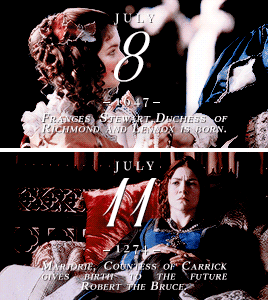
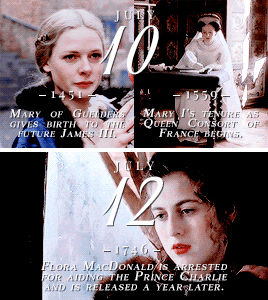


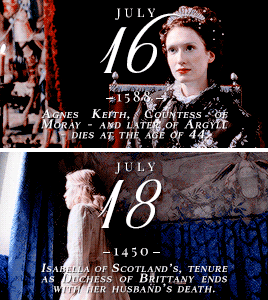



Scotland’s Ladies Month in History ✧ JULY
#historyedit#on this day in history#scottish history#history#medieval history#british history#queen consorts#queens regnant#kingdom of scotland#princesses#clanswomen#house of dunkeld#house of bruce#house of stewart#house of stuart#clan macdonald#gifs#monthinhistory#ours
227 notes
·
View notes
Text
I've been flicking through Gaelic Proverbs and Proverbial Sayings (1926) by T. D. MacDonald, and there are some crackers, especially when it comes to the clans.
Leathaineach gun bhòsd
Dòmhnullach gun tapadh,
Is Caimbeulach gun mhòr-chuis,
Tri nithean tha ainemh.
A MacLean without boast,
A MacDonald without cleverness,
A Campbell without pride-
Three rarities.
Heh.
Spagadagliog Chloinn Dòmhnuill,
Agus leòm nan Leathainich
The MacDonald swagger,
And the MacLean airs.
So, what I'm getting is that the MacDonalds and MacLeans were all gallus bastards. XD
Cha bhi gean air Granndaich gus am faigh iad lìte.
Grants are never gracious till they get their porridge.
Not morning people, then? (Me neither.)
Camaranaich bhog an ime is sliomaran a chàise.
The Camerons - soft as butter and fawning for cheese.
WHAT DOES THIS MEAN?? Would be great to work into a Heron fic!
And, oh, I am definitely working this into a Kidnapped fic somewhere:
Stiùbhairtich, cinne nan righ ’s nan ceàird.
Stewarts, the race of kings and tinkers.
I guess there must've been lots of Stewarts who went around reminding everyone that they bear A King's Name™. :D
67 notes
·
View notes
Text
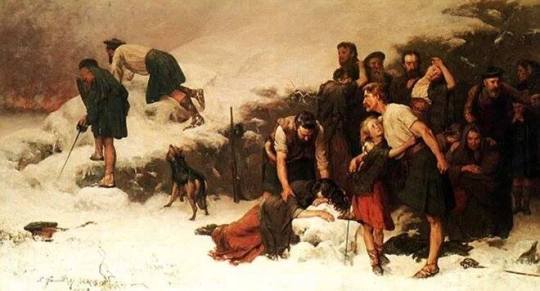
At around 5am on February 13th 1692 the Massacre of Glencoe began……….
The Glencoe Massacre, probably the most infamous and shameful episode in Scottish history, has led to ill feeling between two Scottish clans for hundreds of years.
The shameful atrocity of 13 February 1692 was not, as first believed, a clan feud between the Campbells and MacDonalds, it was in fact a government operation.
Events leading up to the massacre are important to understand the massacre itself.
King James VII of Scotland, and II of England, (a Stuart and a catholic) was deposed by Parliament in 1689, and William of Orange was installed as Monarch, which would lead to the massacre in 1692, and would later spark off the Jacobite Uprisings,the attempts to reinstate the Stuarts to the Throne.
The action was sanctioned and implemented by the Crown, with approval by Lowland elites, and it intensified the already bitter Highland-Lowland divisions.
The actual massacre itself was a direct order from the Master of Stair, Joint-Secretary of State for Scotland for the new King, William of Orange.
Thirty-eight MacDonalds from the Clan MacDonald of Glencoe were killed by the Campbells, (the guests who had accepted their hospitality) on the grounds that the MacDonalds had been slow to pledge their allegiance to the new king.
Besides being ineffectual, it proved to be a monumental blunder, and public opinion was such that the Government was forced to hold an inquest into the affair.
When two advance units were sent to Glencoe on the 1st February they were under the command of Captain Robert Campbell of Glen Lyon, an alcoholic gambler who had gambled away most of his estates. The massacre was to begin simultaneously in three settlements along the glen (Invercoe, Inverrigan, and Achacon) although the killing took place all over the glen as the fleeing MacDonalds were pursued and slain.
On the night before the slaughter, Campbell was given orders to fall upon the rebels, the MacDonalds of Glencoe, and put all under 70 years of age to the sword.
He was told to begin the massacre at 5am on 13 February, 1692, but his superior officers were told to commence at 7am. In addition to the soldiers who were actually in Glencoe that night, there were two other detachments, each of four hundred men, who were, according to the plan, to have converged to cut off the likely escape routes.
Details of the events became public knowledge only because the tormented Campbell leaked his orders to kill in the days after. He had betrayed people he knew. MacIain of Glencoe, the chief of the small branch of the Clan Donald, was a friend with whom he had hunted and fished, and the story goes that Campbell died of his shame.
The scandal was further enhanced when the leading Scottish jurist Sir John Lauder, Lord Fountainhall, was, in 1692, offered the post of Lord Advocate but He declined it, because there was a condition attached that he should not attempt to prosecute any of the people implicated in the Glencoe Massacre.
The Glencoe massacre memory has been kept alive by continued ill feeling between the MacDonalds and the Campbells. Since the late 20th century the Clachaig Inn, a hotel and pub in Glencoe popular with climbers, has had a sign on its door that says ….
“No hawkers or Campbells"
Glencoe is sometimes said to mean 'Glen of Weeping', which may be a reference to the massacre of Glen but the Gaelic 'Gleann Comhann' doesn't translate as 'Glen of Weeping', the Glen is actually named after the River Coe which runs through it and had this name long before the 1692 massacre.I would assume it got the moniker after the events on that fateful day.
42 notes
·
View notes
Text
Clans as Food
Ventrue - those tiny, miniscule proportions you get at those suuuper fancy restaurants that don't even give you the price bc if you're here it's assumed you can afford anything, but my god is it somehow disappointing
Toreador - charcuterie boards that are surprisingly actually nice. The wine pairing is expensive, but there's lot of actual thought into the cheeses, meats, fruit and bread selection
Tremere - expensive hibiscus teas that don't taste like anything. we all joke that tea tastes like 'warm leaf juice lol' but this actually just tastes like that. they swear it's all in the scent. it's not.
Brujah - bar food, but specifically the kind that gets doused in ungodly spicy buffalo sauce. basically, any food that hurts to eat, just for the bragging rights
Gangrel - do you want a cliff bar? you're getting a cliff bar. c'mon, we still have four more miles to go!
Nosferatu - it's three am, you've left your room for the first time in the last sixteen hours, you sit in front of the open door of the fridge eating half a tortilla, a single piece of salami, and handfuls of shredded mozzarella from the bag. it's the best meal you've had in your life
Malkavian - those terrifying white girl beverages from tiktok. about half a cup of coffee followed by whatever and however much syrups, creams, sugar, and spices are in your heart. alternatively, take every party alcohol, pour that and three bags of freezy pops into a five gallon bucket, and enjoy
Banu Haqim - the best goddamn pastrami sandwich you've ever had in your life. also alternatively, vegan food that makes you actually consider going vegan
Salubri - that food that's never what you expect, but exactly what you need, and always what you turned out to be wanting. Halloween chocolate, a piece of simple toast after fasting for a surgery, or just a good drink of cold water
Tzcimisce - hold a match up to a cow. that's how done you want your steak
Lasombra - full english tea service - scones, black teas, finger sandwiches - complete with the butler. this of course must also be goth
Hecata - if you love counting calories, this is the clan menu for you. food that makes you wonder why you're alive to consume it in the first place - spice? what's a spice? alternatively, this is the clan of homecooking that you will never get literally anywhere else. the taste of home. nonna watches you eat with love. she's always watching
The Ministry - gin and absinth. you're not drinking for a good time, honey, and you know that
Ravnos - macdonalds might not be everyone's go-to, but it is a staple of the open road when you can't stop but you really need to stretch your legs. those pickles on the weirdly flattened, heat-lamp warmed cheeseburger you eat with one hand on it and the other on the wheel have never tasted better
#vtm#vampire the masquerade#thirteen clans#food mention#thank you to berd-alert for this wild conversation
77 notes
·
View notes
Text
The crown princess is now the first Australian-born Denmark Queen consort, from the Commonwealth with Scottish roots 🏴
Australia’s Mary Donaldson went from commoner to Danish Queen 🇩🇰
An unconventional journey from Australia’s middle class to European royalty began in an unremarkable bar in Sydney in 2000. Twenty-three years later, in what has been called a “real-life fairytale”, Mary Donaldson, becomes the queen of Denmark 🇩🇰 Queen Mary, not only of Denmark, but of the Inuit in Greenland and the Faroe Islands.
Mary Donaldson was born in Tasmania an island state of Australia in a Hobart’s Hospital in 1972 to Scottish parents. John Dalgleish Donaldson, and Henrietta Donaldson (Henrietta Clark Horne). The daughter of a mathematics professor and an executive assistant who had emigrated to Australia from Scotland 🏴

Her father was born in the town of Cockenzie and Port Seton - (Scots: Cockennie [koˈkɪni]; Scottish Gaelic: Cùil Choinnich, meaning "cove of Kenneth") is a unified town in East Lothian, Scotland. It is on the coast of the Firth of Forth, four miles east of Musselburgh, and her mother was born in Edinburgh.

Mary grew up in a middle-class suburban home alongside her siblings, Jane, Patricia and John. After her graduating with a degree in law and commerce from the University of Tasmania, She moved to Melbourne and Sydney, Mary had a high-flying career in advertising and then worked in luxury real estate. She worked during three months in Edinburgh as an account manager at an advertising agency.
But it was a chance encounter in a busy pub that would ultimately turn her life upside down. The Crown Prince sat alongside his cousin, Prince Nikolaos of Greece, his brother, Prince Prince Joachim, and Princess Martha of Norway at the “Slip Inn” in Sussex Street in Sidney as Australia celebrated Ian Thorpe's first Olympic gold.

Princess Mary and her father John Dalgleish Donaldson at her wedding in Copenhagen Cathedral on 14th May 2004.
The wedding of Frederik, Crown Prince of Denmark, and Mary Donaldson took place on 14 May 2004 in the Copenhagen Cathedral. Mary’s mother Henrietta ‘Etta’ Donaldson died from a heart condition two years before Mary married into royalty.
The Danish Folketing (parliament) passed a special law (Mary's Law) giving Donaldson Danish citizenship upon her marriage, a standard procedure for new foreign members of the royal family. She was previously a dual citizen of Australia and the United Kingdom. Ahead of the wedding, Mary had to give up her Australian citizenship and join Denmark's Lutheran Evangelical Church.

The new Danish queen consort is of Scottish descent. Scotland's and Scandinavia's histories have long been intertwined with smatterings of Old Norse in the language, Viking and Norse settlement in Scotland 🏴
Her father, John Dalgliesh Donaldson, stressed her Scottish roots in his speech at her wedding — and claimed his own clan had once helped eject the Norse from the Hebrides.
Check out the video below and listen her father's speech: “In the 12th century, after much savage fighting, the marauding Vikings were driven out of Scotland by a band of men led by the grandfather of the first Donald, the founder of the clan MacDonald. And for those of you who are not aware, I’m wearing tonight, the dress MacDonald tartan, which is the ancient MacDonald”.
“Donald’s great-grandfather would have wondered why he went to such trouble when, some eight centuries later, we take account of today’s union between the Viking Frederick and Mary of the MacDonald clan.”
Loving words from Mary's father.
youtube
Margrethe II reigned as Queen of Denmark from 1972 until her abdication in 2024. Having reigned for 52 years, she is the longest-serving female monarch in Danish history.
The Queen of Denmark made the announcement in her New Year's Eve speech. She formally hand over the throne in a Council of State today 14th January, 2024 at 2:00 p.m., when she signed the Declaration of Abdication. From that moment on, her son became King Frederick X.
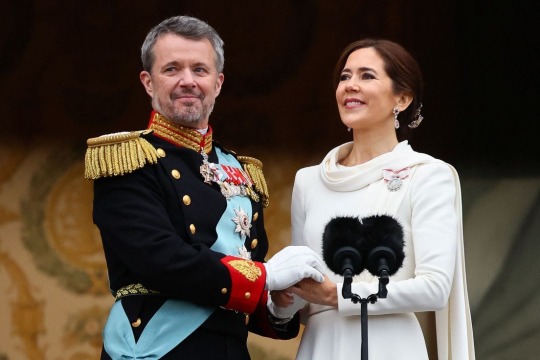
The Crown Princess Mary was crowned Queen consort alongside her husband, the new King Frederik of Denmark. It was a historic moment, for which she wore a historic outfit by the Danish designer Soeren Le Schmidt.
youtube
🎥 credit #dnk.royalty.with.dominik
#MaryDonaldson #Australia #commoner #DanishQueenMary #Queen#Scottishroots #Scotland #Hobart #CockenzieandPortSeton #HenriettaDonaldson #John Dalgleish Donaldson #VikingandNorse #Denmark #Greenland #FaroeIslands #Frederik #KingFrederikX #Tasmania #islandstate
7 notes
·
View notes